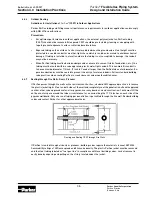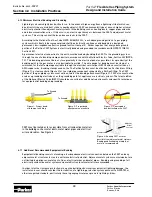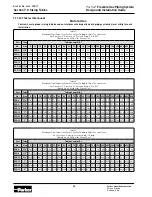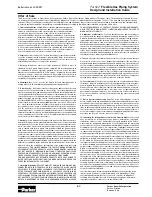
Parker Hannifin Corporation
Parflex Division
Ravenna, Ohio
Bulletin No. 4660-PGP2T
Parflex
®
Flexible Gas Piping System
Design and Installation Guide
Section 4.0 Installation Practices
4.10 Minimum Electrical Bonding and Grounding
Lightning is a known highly destructive force. In the event of high energy from a lightning strike (which can
be a direct strike or an indirect strike to nearby objects), CSST can momentarily be at a much higher or lower
electrical potential than adjacent metal systems in the building such as heating ducts, copper pipes and wire
and telecommunication wires. If this occurs, an electric spark may arc between the CSST and adjacent metal
systems. This arcing can melt holes and cause leaks in the CSST.
According to the National Fuel Gas Code NFPA 54/ANSI Z223, “each above ground portion of a gas piping
system which is likely to become energized shall be electrically continuous and bonded to a designed,
permanent, low-impedance effective ground fault current path.” Parker requires that every above ground
portion of the Parflex CSST System is electrically bonded and grounded in accordance with NFPA 70 (NEC®
Section 250).
Figure 1: Proper bond
attachment on fitting
Figure 3: Unacceptable
bond attachment on CSST
Figure 2: Proper bond
attachment on manifold
A permanent electrical connection to the earth must be made by bonding the CSST to the grounding system
through the use of a bonding clamp and wire in accordance with the National Electric Code, Section 250 (NFPA
70). This bonding point must be in as close proximity to the electrical panel as possible; close proximity of the
bonding point to the gas meter is also desirable if possible. The wire gauge for bonding must be sized, at a
minimum, for the full amperage available through the electrical service (per NEC®) and no smaller than a 6
AWG copper wire. Bonding clamps used on the The Parflex System must be attached to a Parflex brass fitting
(Figure 1), a steel manifold (Figure 2) or to a rigid pipe component connected to a Parflex fitting. The CSST
portion of the gas piping system must not be used for the bonding attachment (Figure 3). CSST also must not be
used as a grounding electrode or as the grounding path for appliance or electrical systems. The latest edition
of the National Electric Code (NEC®) should be consulted for additional requirements and specific techniques
for equipotential bonding and grounding.
Equipotential bonding consists of making a low impedance electrical connection between the CSST and any
adjacent metal structures to create a uniform electrical potential. Adjacent metal systems can include but are
not limited to appliances, metal vents, flues, electrical wires and metal pipes. Bonding and grounding of all
electrically conductive metal systems and metallic structural material is recommended.
In order to further increase protection of an entire building structure from potential lightning damage, the
installer and user should consider the installation of a lightning protection system pursuant to NFPA 780 or
other recognized standard, particularly those in geographical areas prone to lightning strikes.
CSST must be routed as far as possible from all conductive materials
in the building such as metal ducts, metal water pipes and electrical
wires and cables. See Figure 4
4.11 Additional Recommended Equipotential Bonding
CSST
Wood stud
Adjacent
metal
system
Figure 4: Routing CSST as far as
possible from adjacent metal systems.
Bonding and Grounding of adjacent
metal is recommended.
To Ground
To Ground
















































